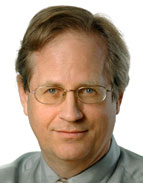Commentary: Alan Boyle
 |
| Photo courtesy of Alan Boyle |
Fear factor
Can physics rock you in the head? Or destroy the world?
These arent the kinds of questions you usually associate with particle accelerators. But over the past year, such questions have drawn the attention of millions of viewers and readers to particle physics in general, and Europes Large Hadron Collider in particular.
There are several reasons behind the interest: Physicists might point to the fact that the LHC is the biggest, most expensive science experiment on Earth, bringing together brainy people from scores of countries. They might delve into a discussion of supersymmetric particles, quark-gluon plasma, and, of course, the elusive Higgs boson.
But I think the main factor is something less scientific, and more psychological: Its the sense of wonder and fear that surrounds the unknown.
Wonder and fear may sound like polar opposites, yet I argue that the LHC wraps them together. Scientists are fond of saying that this miles-wide contraption could create phenomena never seen before on Earth, and its experiments could produce totally unexpected results. That acknowledgment of the limits of our understanding opens the door to a sense of wonder about the unknown—and fear of it.
Fear is the more powerful response—especially when its been so well-visualized in the form of a globe-gobbling black hole. For six months, I covered every twist and turn in a lawsuit filed in the United States that played on the fear of black holes and other unknowns. The doomsday lawsuit sought to have the LHC put on hold because scientists couldnt prove to the plaintiffs satisfaction that there was absolutely no possibility of creating a catastrophic black hole.
Some scientists wondered whether it did more harm than good to write about this case. I had to wonder myself when I heard that particle physicists were receiving threats because of the doomsday talk. I worried even more when I received online comments from kids pleading with me to stop the end of the world. I really enjoy my life and I dont want it to end soon because of science, one wrote.
The Internet can amplify such worries through Web sites, blogs, and forums that are sometimes dominated by people who dont seem to know the difference between science and science fiction. But thats the best reason for addressing the fear head-on. The best way to fill the knowledge gap is by providing answers when you can, rather than scoffing at the questions.
CERN, to its credit, expanded upon its previous safety studies and explained why the LHC wont cause the worlds end, even under the unlikeliest scenario. The court ultimately dismissed the doomsday lawsuit. Theres still the possibility of an appeal, and the fear factor may well come up again in mid-2009 when the LHC is back on line. But CERNs action demonstrated that the scientific community is willing to help ordinary folks face and understand their fear of the unknown— and explain the beauty of the wonders ahead.
Here are a few ideas for building on that foundation:
-
Address the perceived risks—and revel in the benefits: Physicists might find it worth their while to get their message to the public via YouTube videos, blog postings, and even late-night call-in shows. The LHC rap video that attracted nearly 4 million views on YouTube is the best example. It shows that physicists can rock your world and have fun doing it. Next, show how advances in particle physics can lead to new applications in medicine, materials science, and energy.
-
Prepare teachers for tough questions from their students: Based on the comments I received from kids, I got the impression that their teachers werent getting enough information to address the doomsday questions adequately. It might be worth giving a helping hand to teachers at all school levels.
-
Visualize the discoveries: One reason why the Hubble Space Telescope is such a crowdpleaser is because its products are so visible to the public. Hubble is essentially a machine for manufacturing wonders. Are there ways to show in graphic terms what the LHC will discover? Can parts of the subatomic world ever become as familiar as, say, the Eagle Nebula in Hubbles Pillars of Creation?
The task ahead may be trickier than finding the Higgs boson—but anything that makes the weird world of the microcosmos more accessible is sure to make the unknown less fearsome in the future.
Alan Boyle, science editor for msnbc.com, blogs about particle physics, space exploration, and other topics at his Cosmic Log, http://cosmiclog.msnbc.msn.com
Click here to download the pdf version of this article.


